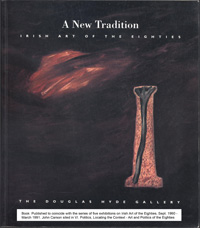
Excerpt from Locating the Context: Art and Politics in the Eighties by Joan Fowler, from A New Tradition: Irish Art of the Eighties, p.128. Published by the Douglas Hyde Gallery, 1990.
Television is regarded as the most pervasive and influential medium and, as such, RTE’s claims about impartiality and objectivity in political matters was under increasing suspicion and attack during the eighties. This was not only from interested politicians but from the public, and is a measure of a heightened awareness of the process of mediation and representation. There is undoubtedly much more skepticism in regard to ‘truth’ in the media, as media professionals, in their own defence, explain the mechanisms of reportage and broadcasting and, as media analysts and film and media theorists dissect the construction of representation. As stated at the beginning of this essay, disciplines and mediums are no longer treated as distinct or discrete entities, and representation, both textual and visual, is increasingly significant for visual artists in how meanings are constructed and ‘read’: Willie Doherty takes care that his photographs do not reproduce press and television image sensationalism; Alice Maher challenges conventions in the representation of women.
News in the media is a story to sell as John Kindness recognizes in his Newsprint Project (1988) where he made headline posters from news each day over a two-week period, which were then distributed to newsagent’s shops. Hence Kindness was able to resituate the political and topical ‘stories’ of the day as mediated by public relations experts, individual witness, and by the press itself. Kindness’s work is often close to satire, in contrast to Nigel Rolfe’s media-based work, and in contrast to John Carson, who comments on the forms in the media and how these can perpetuate racial and sexual stereotypes. In Off Pat (1985), Carson conducts his investigation of prejudices between Catholics and Protestants in the North, between North and South, England and Ireland; and investigates representations of the macho and the feminine, working class and middle class, in a performance in which he drinks bottles of Guinness with slide projection of visual stereotypes such as art reproductions. The style is a comedy act in the popular idiom, but the broken, disjointed narratives of the performance are akin to the inadequacy and gaps in knowledge that create stereotyping. Part of Carson’s effectiveness is his use of live narrative; we are a TV generation and its idioms alone can create response.